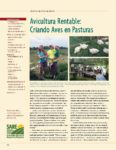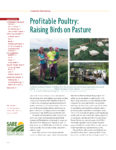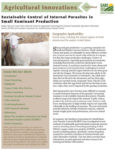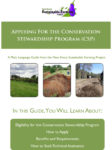Showing 21-30 of 42 results

2014 National Conference on Cover Crops and Soil Health
All session recordings and slide presentations from the National Conference on Cover Crops and Soil Health are available online. Held in 2014 in Omaha, Neb., the event brought together 300 agricultural leaders and innovators to explore how we can make American agriculture more sustainable through improved soil health. Attendees represented agricultural industry, the farm community, academia, government, commodity and conservation organizations.

Avicultura Rentable
Avicultura Rentable: Criando Aves en Pasturas es una guía que incluye experiencias de agricultores y lo último en investigación para criar pollos y pavos usando corrales, cercos portátiles y pasturas.

The Small Ruminant Toolbox
This Small Ruminant Toolbox is a large collection of publications, presentations and other resources that will be helpful to small ruminant producers and educators.

The Ogallala Aquifer of the Texas High Plains: A Race Against Time
As the drought in the Texas High Plains continues to intensify, a unique partnership of producers and researchers is working diligently to find economically viable alternatives to the region’s irrigation-dependent crop monocultures.

Profitable Poultry
Profitable Poultry: Raising Birds on Pasture features farmer experiences plus the latest research in a guide to raising chickens and turkeys using pens, movable fencing and pastures.
Feeding Corn Co-Products to Livestock
These two University of Nebraska manuals discuss the use of corn co-products in livestock rations: Corn Processing Co-Products Manual Feeding Corn Milling Co-Products to Forage Fed Cattle
Storage Methods for Ethanol Co-Products
This University of Nebraska video series contains information on the storage and utilization of three unique co-product feeds from the ethanol industry.

Sustainable Control of Internal Parasites in Small Ruminant Production
Small ruminants (sheep and goats) are adaptable to many different production systems and can be raised with relatively few inputs, but they face huge production challenges. Control of internal parasites, especially gastrointestinal nematodes including Haemonchus contortus (barberpole worm, stomach worm), is a primary concern for many sheep and goat producers and is particularly challenging in humid regions.

Energy Independence: On-Farm Biodiesel Fuel Production
Roger Rainville is ahead of the curve when it comes to reducing costs on his farm near Alburgh, Vt. He’s currently producing biodiesel from canola and sunflower for about $1.70 a gallon.

Applying for the Conservation Stewardship Program (CSP)
This plain language guide discusses eligibility and the application process for the USDA-NRCS Conservation Stewardship Program (CSP).